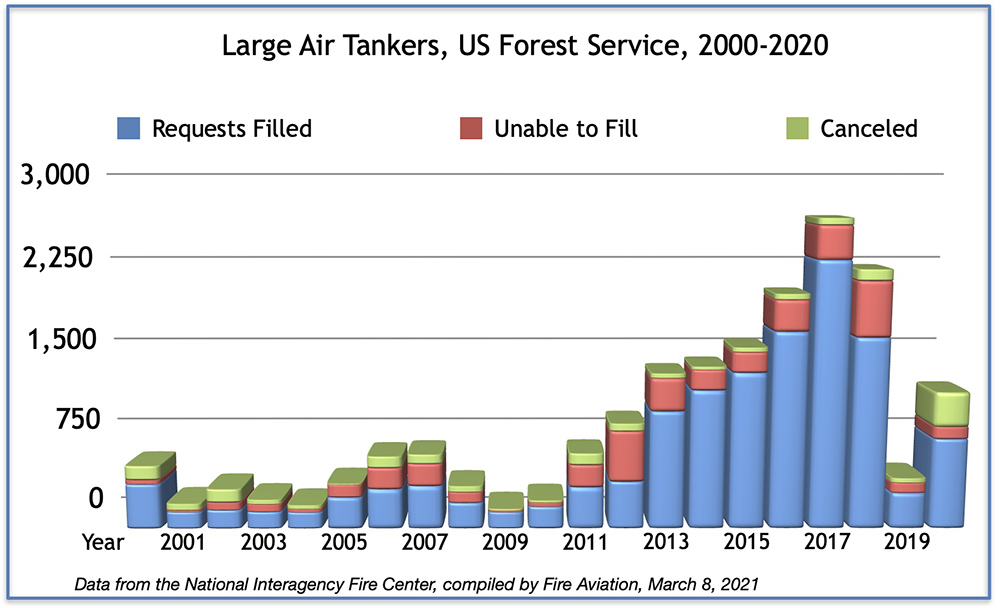
The U.S. Forest Service has 18 large air tankers on exclusive use (EU) contracts this year.
In 2020 the agency started out with 13 on contract in April and May but by June 24 had added 11 on modified call when needed (CWN) contracts for a total of 24. Modular Airborne FireFighting Systems C-130 aircraft from the National Guard and Air Force Reserve were deployed from July 23 until October 4 in 2020, usually two at a time.
This year the 18 EU large air tankers are being supplied by five vendors:
- Six, Aero Flite (RJ85)
- Four, Erickson Aero Tanker (MD87)
- Four, Neptune Aviation (BAe-146)
- Two, Coulson Aviation (C-130)
- Two, 10 Tanker (DC-10)
The dates they will first be on duty could change if the Forest Service decides they need to come on early, but the scheduled 160-day “mandatory availability periods” (MAP) which are different for every air tanker specify that two will begin in March (11th and 17th) and most of the rest will start in April and May. The MAPs end August 18 through November 20 for the 18 aircraft, but those dates could be extended if necessary.
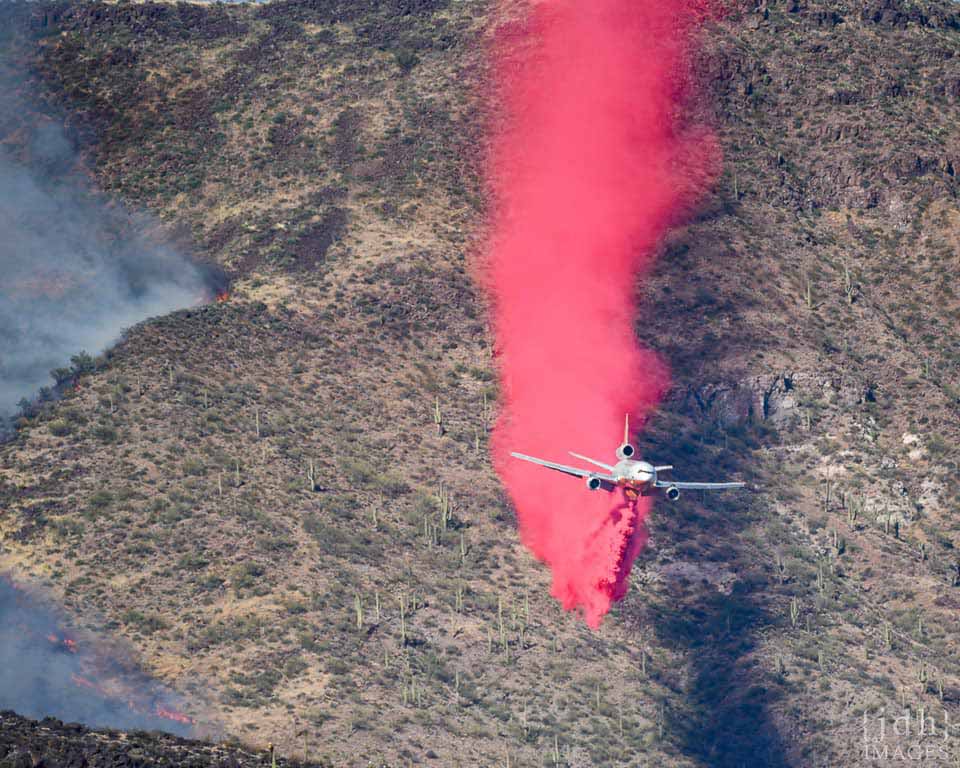
The 2020 fire season started with much less activity than average (see the chart below) but when hundreds of fires began burning millions of acres in the West in mid-August, the number of large air tankers on contract was less than was actually needed. September 19 saw 32,727 fire personnel deployed, the highest number since August 24, 2015 when 32,300 were assigned. Many fires during that six-week period had numerous requests for ground and aviation firefighting resources that were unable to be filled when the fires were discovered. This allowed some of the blazes to grow virtually unchecked for days — or longer. In 2020, 34.3 percent of the requests for large air tankers were either cancelled or unable to be filled.
Since 2001 the four years with the highest number of total fire detections in Washington, Oregon, and California have all occurred since 2015, according to satellite data processed by the New York Times in September of last year.
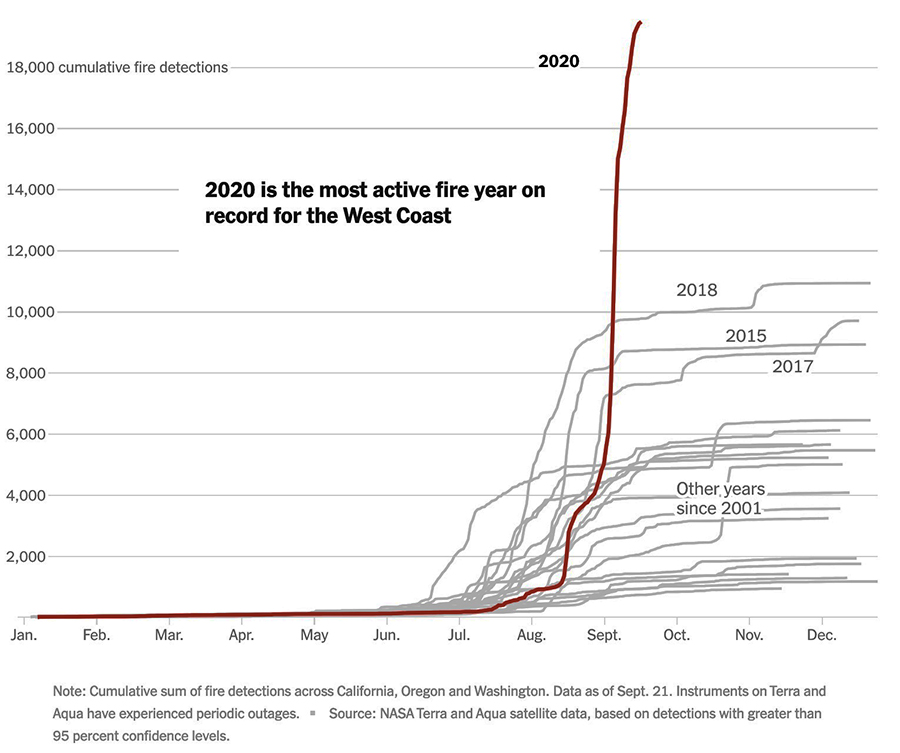
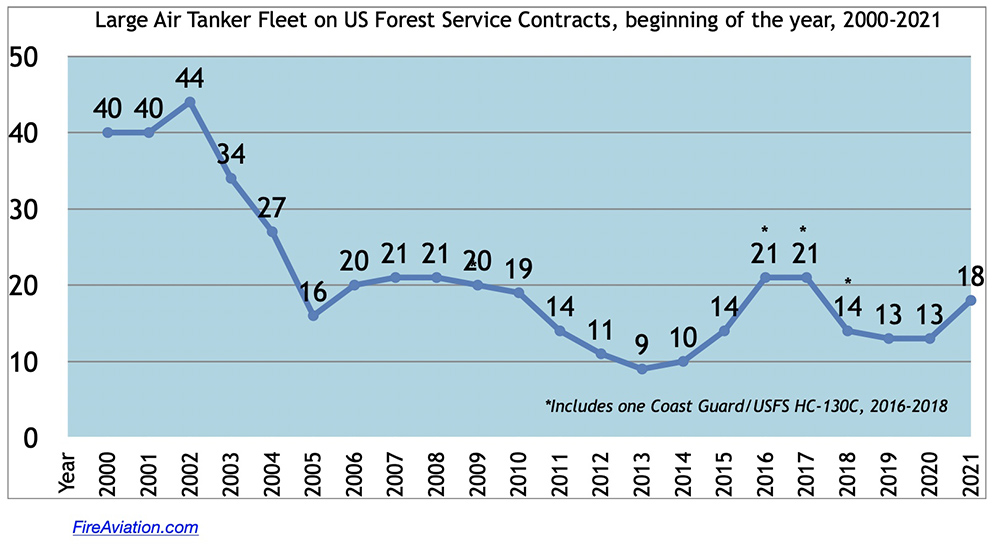

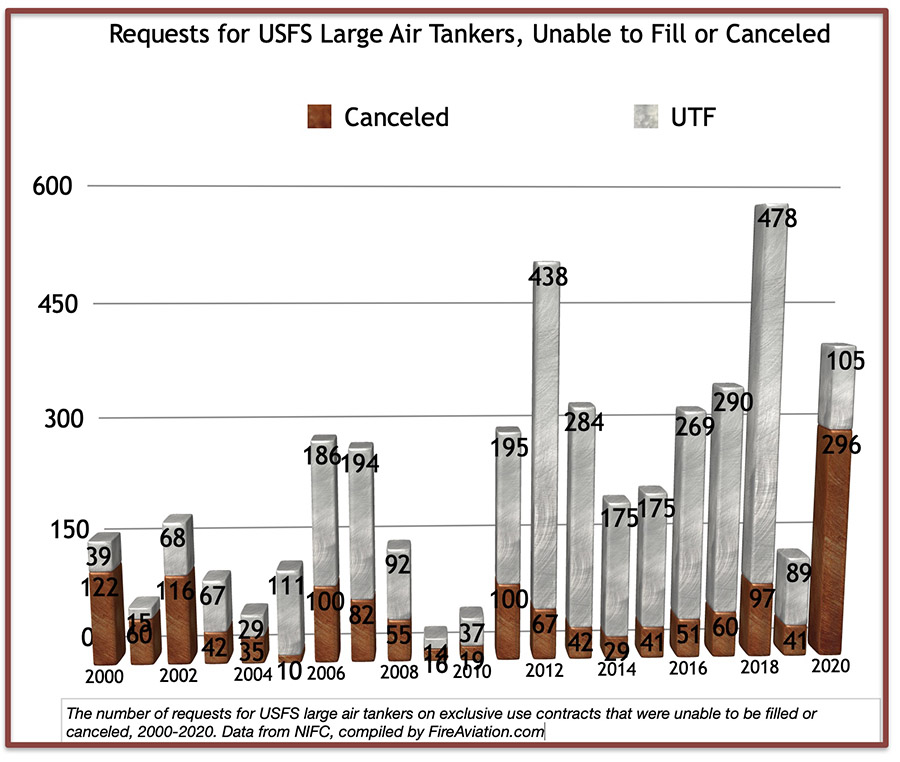
Appears the conversation has run its course here. Going back over the comments I would like to make a few observations.
1. This began with a comment that it didn’t appear that one agency having the large airtankers and another the smaller airtankers was working.
2. Then I added that it would be best if agencies had a mix of aircraft capabilities (small, medium, and large) for different missions making the point
that the key was to get retardant or suppressant on the fire ASAP during periods of high fire danger. And made the point that a fire manager
would be more likely to send a smaller aircraft on report without needing someone on the ground to verify the need than a large airtanker.
Summarizing – have a dispatch protocol to automatically dispatch airtanker(s) automatically during periods of high fire danger in high fire hazard
areas during the burning period. Which gets back to having adequate numbers of appropriate aircraft to give coverage within 30-40 minutes.
3. This was followed by a lot of input regarding effectiveness of large airtankers (or lack thereof), airtankers vs. helicopters, helicopters with buckets
vs. tanks, need for firefighters on the ground to follow up drops, etc.
4. And DC Wildfire Analyst posting a report that documents that the earlier retardant is delivered the more successful it is – which basically verifies
the case I made originally. This just happened to be a study of large airtankers. My guess is that thousands of grunt firefighters could have told us
the same thing. This issue has been discussed since the advent of the airtanker and many of us have known the value of airtankers on IA and much
less so on conflagrations.
5. I hope the heralded Aerial Firefighting Use and Effectiveness (AFUE) Study will concentrate more on large fire use than IA control efforts before a
fire is off and running.
So, it has been a good dialogue (which even drew in Mr. Gabbard in documenting the continued viability of the P-3) and hope there is at least some level of concensus that when needed the quicker aerially retardant is delivered (by whatever means) the better which requires a mix of aircraft type and size. And how the aircraft mix is determined to be the most cost effective is the perennially management challenge and will probably always be affected by personal bias and experience.
Thanks for that Bill..
Are they being used under federal contract, or just state agencies. I saw in your attachment that Colorado had hired one.
Cool to see those old aero union planes back to work….
Richard,
Just curious what agent you were using as a suppressant.
P3’s got the axe some years ago. A couple of electra’s stayed active in Canada after that, but I’m thinking they might be retired as well now…..
Folks currently in the job would know better than I…
P3’s were a great air tanker…
P3s are still alive and well. Check out our tag: https://fireaviation.com/tag/p3/
Good morning, Bill,
Thank you for the above URL!
You just opened up a whole new world to a veteran thirty year career P-3 guy.
My background includes fourteen years as a navy aircrewman Sensor Three (Radar/MAD, Radio Operator and flight engineer) , nine years as a P-3 flight simulator technician, sixteen years as a Navel Aviation Service Unit (NAESU) Tech Rep and still going strong as a member of the Moffett Field Historical Society (we have two P-3 examples – one complete aircraft (BUNO 150509) and a complete cockpit from (BUNO 150357). Please come out and visit us sometime!
I just about had a cardiac arrest when I opened the site!
Thanks again!
Yes they ARE! They are the wildland fire fighter’s best air support by their design.
I sense the “love affair” with big aircraft but the bottom line for any IC is “effectivebeness,” and the big airtankers tend to drop too high and disperse retardant too far from the need.
In open terrain, LATS can be very effective as they are not hindered by canyons and steep slopes, but in the mountains they cost more than they are worth.
Ted..
Agree, there does seem to be a “love affair” with the large air tankers….I don’t have a lot of experience with v-lats, but my experience with the next gen large air tankers is somewhat more positive than yours. I think the positive versus negative outcome has a lot more to do with the type of fire behavior they are utilized on. All too often they are used on a fire that’s not catchable….doesn’t matter what you throw at it. There are pressures on operational foplks and air attacks to “Do something”, cost be damned…
There are arguments on both sides of the overall effectiveness versus cost and it would take a truck load of cold beverages to sort that all out…
Put me in steep timber country and my tool of choice every time is a skycrane or Chinook with a bucket on a 200′ line…no belly tanks, got to be a bucket on that long line…. that’s not cheap either, but man, can it be effective.
And don’t forget, retardant is more effective if you have ground resources to back it up. That’s not happening, which increases the demand for retardant, so it’s a contributing factor in the need for more air tankers. Doesn’t matter if it’s a SEAT or a DC-10. LOTS of red stripes in the middle of burns out there.
Affectionately known as “fire art” in the aerial business…..
Agreed on the fact that air support has turned into something other than “support” ..
Agree to disagree, but tanks are the only way to go on helicopters!
My experience has been in steep slopes(think hells canyon) tanked helios drops end up way too high above the target and get disbursed….tanks and snorkels work better in texas for delivery and sucking out of small tanks….
Different horses for different courses…
Let me throw in a different wrinkle. In 2006 during a 5 month fire siege in Oklahoma we brought in 6 SEATs under BIA contract worked them in tandem, but instead of dropping fire retardant. We dropped fire suppressants. Fire suppressants worked better than fire retardant in the predominately light fuels involved in the fast moving grass fires and yes we used air attacks because of the mixed use of helicopters and heavy airtankers. The GACC pissed me off when on a regional conference call they told me to “cease and desist” the use of fire suppressants as I was outside policy. The coordinator told me he had the red book in his hand if I wanted him to read the policy to me. I told him instead to read the signature page and he wouldn’t find a BIA signature as what he had in his hand was not -BIA policy. I then asked him if I needed to send him a copy of his Fire Director’s, Tom Harbour, memorandum that said I could even drop it on Forest Service ground. Cease and desist sounds like something a judge says, not an agency cooperator.
Go big…go early
MANY fires have a really narrow window to be caught at IA. Fire managers holding back for a “what if” potential are playing a bad hand. Fight the fire you have. Adjust as necessary. Adjust the I.C. as the fires exceeds experience/capabilities/quals.
Air attacks and SEATS/ Helios and even large air tankers should all be dispatched immediately if burn conditions are at a problem threshold. As an air attack, it was a real pain in the butt to show up late into the IA game and play catch up…would much rather get there early to be able to observe burn rates, fire behavior and start to wrap my head around what we had in front of us..
Should not be a big deal to jettison a SEAT….every aviation manager should have a couple of options, along with aircrews and dispatchers briefed on protocols..
I did my atgs training 20 years ago when there were over 40 large AT’s and a smattering of SEATS. For the money thats being spent on these humongous project fires, there is no way we cannot justify a doubling or tripling of I.A. resources.
The one caviot I would add is that for every dollar spent on IA, an equal dollar should be spent on fuels reduction and management.. successful suppression is not an end unto itself..
What is the status of the P-3 Orion air tankers. Are they still in service?
You are forgetting one small detail, the wild land policy is to let it burn…. until they get too much flak.
Not the people on the ground but the ones in Washington who just don’t care about the west.
I agree with Ted.
Jeff, I think you just made the case for dispatching a SMALL airtanker at first sign of smoke and put the damn thing out. It’s upfront money well spent, given the cost of a fire taking off.
Well, I think the helicopters should go first, but anything you have that can get off the ground quickly (which SEATs can do) is the way to go. But as was mentioned above, they have to be able to reload close by to continuously be effective, unless, of course you get them there while the fire’s still small, and that’s all you need, which is our original point, right? Heck, maybe another incident can use the retardant if you can’t.
I think everyone who’s reasonably informed about wildfire suppression can agree on one point — the true experts are the incident commanders on the ground responsible for mitigating the risk of small fires exploding into mega or giga fires burning over 100,000 acres.
I imagine everyone can also agree that the wildfire threat is growing exponentially. There are more fires igniting every year. And the fires a burning hotter and faster.
So, is 18 large tankers enough? Would more large tankers help prevent mega disasters costing the American taxpayer billions annually? According to the only credible study I’ve ever seen on the topic, yes, large tankers are highly effective — https://fireaviation.com/2020/02/28/study-shows-correlation-between-rapid-dispatch-of-air-tankers-and-duration-of-wildfire/.
Then consider what the expert incident commanders want. They are asking for more large air tankers in order to perform their missions. But, their demands for tanker support cannot be met by the current supply (18 large tankers under Exclusive Use contracts, and no guarantees that Call When Needed aircraft will be available).
Here it is, written by U.S. Forest Service officials and released in 2020, but on nobody’s radar — hundreds and hundreds of calls from incident commanders going “Unable To Fill” (UTF). Link to report — https://www.mdpi.com/1999-4907/11/2/217/htm.
The result — billions of dollars in damage that could have been avoided by spending in the millions. Penny wise, pound foolish.
All good points, except I would venture to say that most Initial Attack ICs don’t have the training or experience to be experts in aircraft use on fires. There is no training that prepares them to know what aerial resources they need, and rely on Air Attack to provide them with recommendations. Too often I hear, “order what you think you need”. Ground resources need to be aware of what aircraft are available in their area and the capability in order to make informed decisions based of fire activity and potential.
But, you’re right, the study (and Dr. Gabbert’s Rx) are the obvious answer to keeping more fires small. Is that better in the long run? A mess, for sure.
Most IA ICs don’t have the training or experience to be experts in aircraft use on fires….Really? Wow, things sure have changed in a few decades. I don’t think you have to be an “expert” but back in the days of old, an engine captain (foreman in my day) knew when they knew they needed more resources. And if the captain didn’t know, you had the ADFMO, FMO, and Dispatch with enough knowledge and expertise to place the order for air tankers. These people knew their response area, they knew the weather. Doesn’t the Battalion Chief monitor fires and equipment in their response area and can determine and approve air tanker drop? If Engine Captains are given the authority then the training must go along with that authority. Playing catch-up never works out.
I got introduced to SEATS early on…was the late 90’s and the program was in it’s early days..It has progressively gotten better. Utilizing tubine powered 802’s is pretty much standard, except for a few state hired contractors.
There is a knack to using SEATS effectively however…you need multiple aircraft and multiple loading sites. Any given fire will have it’s own flight distance and time to the nearest reload option.
As that radius increases, it takes additional aircraft to maintain an effective operational effect.
Alaska, both state and feds, tried SEATS back in the early 2000s… was a total failure…sending a single seat, or even a pair, to a fire 150 miles out. Those kind of distances /time frames are what large air tankers are for.
Later on, utilizing firebosses proved to be pretty successful and was/is a popular tool, especially with the jumpers.
Goes to show, you don’t always need 3000 gallons of the red stuff all at once….as a ground pounder, often times I would prefer to have a little air support every 10 minutes, rather than wait an hour plus for a large AT to do a load and return….it’s all about holding what you got…
On the other end of the spectrum, the blm in eastern montana put some effort into setting up multiple reload options across the district and would staff up with multiple SEATS in higher fire danger. I worked a number a number of fires as an air attack there in the early 2000s and came to appreciate the value of operating SEATS in that manner.
I don’t know if thats how they are still operating in eastern mt….I would sure hope so.
Finally, I will add that the next generation large AT’s are an impressive tool. They are fast…have good payloads…safe and maneuverable in tough terrain…and..they don’t break down every 5 or 10 missions…well, thats maybe a little harsh on our old legacy airtankers…loved em, remember my first B 24(I think that was it) doing a drop ahead of us on I.A. in the mid 70’s….also loved the sound of Hawkins and Powers KC97 showing up…could hear him 10 minutes out…but they sure broke down a lot…lol..
For sure there are issues in the wildland fire business….as has been discussed in numerous threads on this site….
There are however, some real positives as well. Upgraded aviation assets is definitely one arena you can look at and know that it’s a whole lot better now than it was even 20 years ago.
Jeff – Agree with sending the air attack out also. We included the air attack with any airtanker dispatch on the unit. Keep in mind that the automatic dispatch of air attack and airtankers was only during the burning period in high fire hazard areas on high or higher fire danger days. I have to admit that I do not know what capability SEATs have to land with a load or something less than a load. Even if they have to jettison a load the avoidance of just one large fire high fire hazard area during a period of high fire danger is a bargain for the price. By the way – what is an IMO? I guess my obsolesence regarding new terms is showing.
In my opinion (IMO), I still think that many Fire Managers are going to be hesitant to launch air tankers on any report of a fire, even during high fire danger. I also think that under most IA responses, the first in units contain the fire at a few acres or less, where it doesn’t make sense to drop retardant, risk management-wise and other-wise. Many times, if the fire is caught soon enough, the air tankers don’t even get off the ground. CALFIRE has had success (mostly) in this regard, because they have a lot of resources close by to any start. Regardless, the cost of a load of retardant vs the cost of a multi-thousand acre fire is negligible, and Fire Managers should look at what conditions air tankers should be dispatched. First report of a fire? Smoke visible? Very High to High Fire Danger? Location? It’s up to them, but right now, more often than not, it’s usually too late.
IMO, units are going to continue to be reluctant to send air tankers on initial report of a fire because of the cost associated with having to jettison a load when they are cancelled. Helicopters are more cost effective, but may not be enough if the fire starts to escape IA, but at least you get an aerial asset sooner than later. Also, send an Air Attack right off, they can help determine aircraft needs.
To Jeff: Then don’t jettison the load; drop it on the fire. When someone turns a fire in, they are always asked about the fire (how big; are you on sight; what does it look like; etc) and from that info they order up a response.
I agree with Ted regarding the USFS need to utilize more SEATs for a faster response to fire starts. Fire managers are also more apt to order a smaller, less expensive airtanker for a fire especially during high fire danger periods as opposed to waiting for someone to get to the fire and decide whether or not an airtanker is needed. Back in the 1980s we initiated an automatic dispatch of two medium airtankers on high fire danger days during the burning period in our high fire danger areas with great success.
The Forest Service needs a mix of aircraft small, medium, and large to have a more efficient, effective coverage. Sharing fire resources between forests in the same region let alone between national level agencies in different departments has bottlenecks. There is little question as to the value of sharing resources, but at best there is time lost to go through all the channels and hoops to get resources from another agency especially during periods of high preparedness levels. The owner of the resource looks to their own needs first regardless of the higher need.
I think a better level of preparedness sharing is at the more local level like between Cal Fire Lassen-Modoc Unit, the Lassen and Modoc National Forests, and the BLM Susanville District. At that level they can jointly determine their aircraft needs and develop protocols they will implement to use shared resources. Some of that is going on now and has been for a number of years, but conflicts at the upper levels tend to impose limitations in favor of their own organization.
It sounds good to share air resources at the national level, but keep in mind these are large bureaucracies we are talking about here. For example, if the Cal Fire/Lassen-Modoc NFs/Susanville BLM group thinks they need one or two SEATs at their air tanker base (which they could move around their area of influence as needed) it is much more reliable than depending on the Boise Interagency Fire Center (BIFC) allocating SEATs on request from this combine during periods of need. My guess is that more often than not the combine will not go through the hoops of requesting the prepositioning of aircraft from another base to theirs. And there will be the other extreme where some units will over request. And meanwhile the home bases of the SEATs will often drag their feet to keep them in place. Not diabolical – just the way we humans function.
Sharing is a commendable trait, but it has its limitations. It also requires honesty cooperation, and reliability which works best at the level where the participants work together on a regular basis and depend on each other. Which in this case I would recommend that each multi-agency coordination unit (whatever that may entail from the one described above to a single agency determine their level of need at some level (like 85-90%), staff to that level, and then share with the world based on national agency coordination. Which a national agency agreement on a common aircraft contract would be desirable, if not required. Currently, the battles between national agencies is significant. They play up the benefits of cooperation and brag about some successes like the BIFC, but there is still significant conflict from the top down through the ranks that affects coordination and sharing.
More SEATs? Good grief…
I’d like to hear more about the so-called “Agreement” between the USFS and BLM regarding who gets the large airtankers and who gets the smaller ones (SEATS).
The USFS needs the SEATS much more than the LATS. Just look at the terrain they manage vs BLM’s land base. If there were to be an Agreement, the LATS should have gone to the BLM.
Now we see the USFS lining up their large airtanker force once again. It actually fits their “wildfire strategy” of “managing fires when they’re small” then bring in the large airtankers when the fires get out of control. What could go wrong!!? Many of us feel the agency needs to realign their strategy and hit the fires early and hard, and disperse SEATS around the Western US in high risk zones, combining BLM & NF risk assessments.